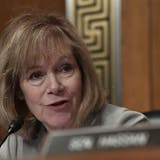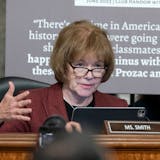Minnesota's Native women legislators are spearheading the creation of a new state office to bring the largely hidden epidemic of missing and murdered Indigenous women and girls to the forefront.
They're behind legislation to establish a Minnesota office of Missing and Murdered Indigenous Relatives, which would pull in data from state and federal sources on missing person cases and unsolved murders of Native American women and men. Unlike other races, Native missing person cases aren't tracked in any comprehensive way.
Thousands of red dresses were displayed across the Minnesota Capitol lawn Wednesday for a national awareness day, representing Native relatives who have been lost.
"It's powerful to look across this lawn and see the visual representation of an issue that, for far too long, has been invisible," said Lt. Gov. Peggy Flanagan, a member of the White Earth Band of Ojibwe. "Every Native woman I know is related to at least one person that has been affected by this issue. This violence can no longer be swept under the rug."
The office would also provide assistance to law enforcement during active missing person cases and conduct reviews of cases that have been — in some cases — cold for decades. It would link up with a new federal cold-case unit established by Interior Secretary Deb Haaland, the first Native American to lead a U.S. Cabinet agency.
"This is still happening in our communities," said Sen. Mary Kunesh, DFL-New Brighton, a Standing Rock Lakota descendant who is sponsoring the Senate bill. She pointed to a February sex-trafficking sting in Itasca County that included two workers on the Enbridge Line 3 pipeline project.
"There are direct correlations between sex trafficking and the extracting industries, drugs and alcohol and homelessness. All of those things contribute to the vulnerability to the Native population, especially our women," Kunesh said.
The office was one of 20 recommendations delivered to the Legislature in December from a task force that spent two years digging into why Indigenous women are victimized at such staggering rates.


